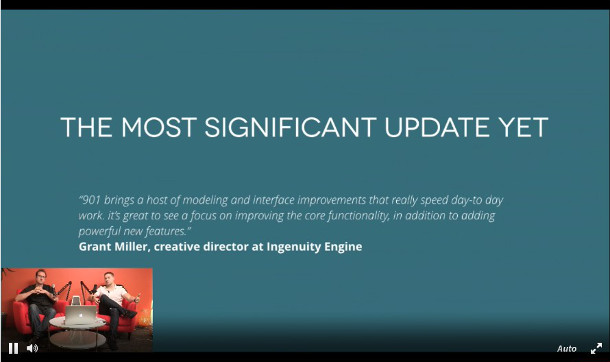The Foundry announces Modo 901
The Foundry has unveiled Modo 901, the next update to its modelling, animation and rendering package, in an online event hosted by President of the Americas Brad Peebler and product marketing manager Shane Griffith.
New features in the update, which is expected to ship in May, include the integration of Boolean modelling plugin MeshFusion into the software, progressive texture baking, and a range of new modelling and texturing tools.
In addition – not announced in the livestream, but reported on fxguide – the implementation of Multiple Importance Sampling in Modo’s renderer has been updated, promising faster, cleaner renders.
MeshFusion now free with Modo 901
The first feature to be announced wasn’t strictly a new one – at least, not if you’ve already bought subdivision surface Boolean modelling tool MeshFusion in its current incarnation as a $395 add-on.
As well as shipping free with Modo 901, MeshFusion has been more tightly integrated into the Model layout and will function as “more of a first-class citizen” within the software.
Its core has also been improved – original creators Darrel Anderson and Boris Tsikanovsky have both worked on the update – although beyond improved performance on lower-res meshes, there were no more details.
Anyone who has just bought MeshFusion – something of a sore point in chat during the livestream – will get the core improvements as part of a free update to the standalone edition, even if they don’t upgrade to 901 itself.
Progressive texture baking
The next of the new features on show was the option to use the progressive refinement view for baking textures as well as displaying the progress of renders.
The scene itself remains fully interactive during the process, meaning users can continue to sculpt or texture a model and see the baked texture update in real time.
According to Griffith, the new functionality refines a toolset “we fumbled on with 701 and 801 … we thought we had it right, but when we got to ship we realised it was a much bigger problem than we thought”.
Improved UDIM support and UV handling
Other texture-related changes include better handling of Mari’s UDIM texture format, introduced in Modo 801. Modo can now automatically process multiple mesh items, packing each one into its own UDIM texture space.
A new Linear Align UVs feature enables users to copy and paste UVs between models with the same topology. If the source and destination model are not perfectly aligned, Modo will rotate the UV map automatically.
There is also a new Rectangle UVs tool for generating uniform UV strips from objects like tubes and pipes: in the demo, it looked like a more focused alternative to the existing UV Peeler.
And, although it was only mentioned in passing rather than revealed formally, it looks like that in Modo 901, it will be possible to display UV boundaries in the viewport itself.
New sculpting and modelling tools
However, the guts of the update – at least in terms of the number of features announced last night – lies in the changes to the modelling and sculpting toolsets.
In the latter camp, multiresolution sculpting now supports layers, including the option to weight layers negatively.
In the former camp, a new Radial Align tool creates clean geometry when making elliptical selections from rectilinear meshes, and a Linear Align tool automatically straightens edge spans.
Selection workflow has been improved: edge loop selections that previously took two or three clicks should now take one; and topological symmetry makes it possible to make symmetrical selections on asymmetric models.
There are also new options for multi-edge slicing and slicing “with gaps and caps” – the option to automatically remove volume along a cut to leave room for glue when printing a 3D model in sections.
Finally, a new Curve Fill polygon type automatically fills holes bounded by curves.
Faster, less noisy renders of heavy production scenes
But one of the key features in Modo 901 wasn’t revealed in the livestream, but via an article posted on fxguide.
According to fxguide, Modo 901 will implement Adaptive Light Sample Allocation (ALSA) in the Multi Importance Sampling system used in the software’s final-frame renderer.
The article goes into more technical detail, and is worth reading in full, but the upshot promises to be a substantial performance boost, particularly on scenes lit by large numbers of direct light sources.
In addition, the demo shown in the article uses a “highly specular GTR material” – which presumably means that The Foundry has implemented the Generalised Trowbridge-Reitz BRDF model, also used in V-Ray 3.0.
Price up for individual licences
The final change in Modo 901 affects not functionality but pricing. According to The Foundry’s website, both individual and floating licences of Modo 901 will cost $1,799. Currently, individual licences are priced at $1,495.
At time of posting, anyone buying a new individual licence of Modo 801 at the old price – or upgrading from 701 – will get Modo 901 for free when the the software ships.
The most significant update yet?
As has become traditional in recent releases, Modo 901 was described as “the most significant update yet”.
At this stage, that’s probably something you have to take on trust: the features on show so far, strong though they are, are evolutions of existing toolsets, not revolutionary new ones.
As one fairly typical comment on The Foundry’s forum put it: “I really like everything I’ve seen today but none of that would make it the most significant update to Modo yet.”
However, with Modo 901 not expected to ship until late May, and further announcements promised between now and then, that’s something that may yet change. We’ll update when new features are revealed.
Read more about the new features in Modo 901 on The Foundry’s website

